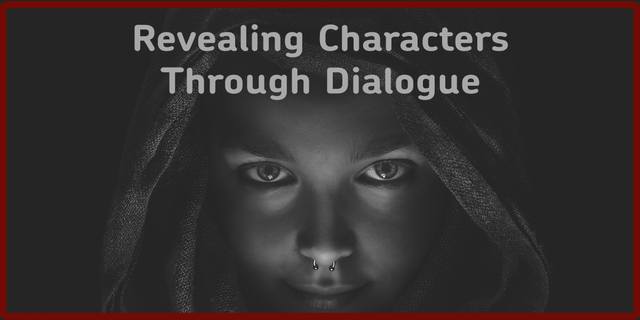
This is a follow up blog to Using Dialogue to Show. Not Tell. If you haven’t read that blog yet, you might want to before reading this post.
The story I shared in my last post primarily used dialogue to reveal my characters. There’s a little bit of narrative too, like body language and setting of course. I’m going to go through the choices I made in the dialogue as a case study, but first it’s important to know a little bit more about the different kinds of dialogue.
Types of dialogue
It shouldn’t be surprising that you can reveal characters with multiple types of dialogue. In fact, there are two basic types: Direct and Indirect. They are defined pretty much as you might expect, but let’s look at some examples of each.
Direct Dialogue
“Such a thing does not exist,” OreSeur said firmly. (135)
That’s an example of direct dialogue from Brandon Sanderson’s Well of Ascension. Here’s another:
Is it me, or has he become stranger since we last met?(76)
Both are direct in the sense that we see the character say, or think, them. We’re hearing the words right out of their mouth – or mind. Normally, the dialogue is set off somehow, either with quotes or italics for thoughts. While quotes for words being said is standardized formatting, how thoughts are formatted isn’t. Most genre fiction these days use italics and some tagging like “he thought” to let you know the words aren’t said but are directly from the character. If you see it formatted differently, just go with the flow.
Thoughts can be referred to as “internal” dialogue too.
Indirect Dialogue
As you may have guessed, indirect dialogue is when the words said are NOT coming directly from a character. Here’s an example from Well of Ascension again:
He had spent quite a bit of effort explaining to the elders why writing was so important. (72)
Here, the narrator tells us about a conversation that happened rather than having the reader see that conversation. This technique is used to inform the reader of a conversation when the fact a conversation took place is more important than what was said. In the example above, it’s easy to imagine the character repeating himself over and over based on the “quite a bit of effort” he needed to make. Summarizing what happened keeps the pace of the story moving along and spares the reader from shoveling through dialogue that ends up being irrelevant to the story.
Which type should you use?

Short answer is: both. The caveat is: when appropriate. Both types can be used to reveal characters.
In the indirect example above we see the character is likely patient and certainly dedicated to take so much time to explain things. And the reader learned this fact quickly, without having to read through a bunch of direct dialogue to learn it.
Direct dialogue, in contrast, is used when the content and how it was said matters. We’ll use my short story “Quiet” from the last blog as an example to analyze. Again, if you haven’t read it yet, go check it out here.
Choosing to reveal characters through direct dialogue
In “Quiet”, the two characters are arguing. I chose to use direct dialogue, in part, because they are stuck in the car together. Mary is somewhat content to sit in the silence with her thoughts, but Morris can’t help himself and Mary can’t escape. Plus, the scene wouldn’t be intense or strained if the narrator relayed their conversation in indirect dialogue. In Creative Writing and Stylistics, Jeremy Scott describes indirect speech as where the narrator “reports these words second-hand” (105). Later, he says that in indirect speech, the “colloquial features and emotional force of the actual speech are lost” (107). In this story, the emotional force was key to the tension and understanding the underlying argument, which is why I chose direct dialogue as my narrative technique over indirect dialogue.
Revealing Morris
In Morris’ dialog he qualifies his statements with phrases like “You know”, “I know”, and “Don’t worry”. These are not confident phrases but rather fillers or feel good word choices. It’s as if he doesn’t want to say anything firmly so he couches his words with these small phrases. Over the conversation, it makes him seem a little shifty and that maybe Mary has a reason for being suspicious.
Revealing Mary
Mary’s dialogue is firm and direct. She’s questioning everything, asking him to confirm details and to take action. There are also peeks into Mary’s thoughts using internal direct dialogue. These small glimpses let us know she’s confused, disbelieving and requires proof from him. These clues help the reader know that the argument is about more than just this one thing that happened. The underlying issue is the lack of trust in their relationship, and the exchange of direct dialogue shows this and reveals each character in the process.
To Learn More
Much of what I wrote in this blog I learned in one of my classes, but I’ve also found some other resources that I find helpful in learning how to use dialogue well. Here’s a short list:
Do Your Characters Talk Too Much? This blog is a funny take on the process of learning about indirect dialogue and offers solutions to nine common dialogue problems.
What is indirect dialogue? This is from the Writer’s Toolbox on Gotham Writers. It’s worth a look as there are many questions and answers about writing in general.
Inner Dialogue-Writing Character Thoughts Here you’ll find a good explanation for when and how to use internal dialogue.
NOTE: This post was meant to appear on Steemit using SteemPress but for some reason autoposting didn't work.

Available Now on Amazon




Join the Freewrite fun today! Visit @Freewritehouse
Proud to be part of the

Please the Bananafish god by entering the Finish the Story Contest

All images are mine or licensed from Adobe except where noted. Freewritehouse, and the Bananafish Tribe used with permission from their owners
Featured image source: Image by Free-Photos from Pixabay
)
MAM! On Amazon Kindle how much a new fiction book can make?
Posted using Partiko Android
Downvoting a post can decrease pending rewards and make it less visible. Common reasons:
Submit
Hey @saun. How much it can make depends on a lot of things. There are people on the internet saying if you write a book on an in-demand topic you can make an average of $500 a month without any marketing or effort. That sounds too good to be true so it probably is. I subscribe to a research group that analyzes which fiction niches are doing well and the trends that are happening so I can focus on hot topics. But it still takes marketing (that means money) to really get noticed and get your book going.
Starting out with reviews is a big help too. That means getting people to read it ahead of time so they can review at launch. But even when you do everything right up front to launch with reviews, the reviews may not come or the people may not be able to post reviews on Amazon due to their limitations and rules.
So there are lots of factors to consider, but the one thing I've found that seems consistent is the more books you have on Kindle the more likely you are to earn money from them. I just started publishing and did quite well when my book was on free promo. Now that it's paid I've dropped in the rankings since I've stopped my marketing. I'll pick it up again once book 2 is ready to go.
At some point I'll write a post about everything I've learned about publishing to Kindle, so keep an eye out for it. Feel free to ask questions in the meantime.
Downvoting a post can decrease pending rewards and make it less visible. Common reasons:
Submit
Thanks mam! @ntowl. I recieve this message now. Partiko is not working properly.
Posted using Partiko Android
Downvoting a post can decrease pending rewards and make it less visible. Common reasons:
Submit
Hi @ntowl!
Your post was upvoted by @steem-ua, new Steem dApp, using UserAuthority for algorithmic post curation!
Your UA account score is currently 2.889 which ranks you at #12474 across all Steem accounts.
Your rank has not changed in the last three days.
In our last Algorithmic Curation Round, consisting of 92 contributions, your post is ranked at #56.
Evaluation of your UA score:
Feel free to join our @steem-ua Discord server
Downvoting a post can decrease pending rewards and make it less visible. Common reasons:
Submit
Hi, @ntowl!
You just got a 0.96% upvote from SteemPlus!
To get higher upvotes, earn more SteemPlus Points (SPP). On your Steemit wallet, check your SPP balance and click on "How to earn SPP?" to find out all the ways to earn.
If you're not using SteemPlus yet, please check our last posts in here to see the many ways in which SteemPlus can improve your Steem experience on Steemit and Busy.
Downvoting a post can decrease pending rewards and make it less visible. Common reasons:
Submit
Congratulations! Your post has been selected as a daily Steemit truffle! It is listed on rank 21 of all contributions awarded today. You can find the TOP DAILY TRUFFLE PICKS HERE.
I upvoted your contribution because to my mind your post is at least 3 SBD worth and should receive 142 votes. It's now up to the lovely Steemit community to make this come true.
I am
TrufflePig, an Artificial Intelligence Bot that helps minnows and content curators using Machine Learning. If you are curious how I select content, you can find an explanation here!Have a nice day and sincerely yours,

TrufflePigDownvoting a post can decrease pending rewards and make it less visible. Common reasons:
Submit
Thank you @trufflepig!
Downvoting a post can decrease pending rewards and make it less visible. Common reasons:
Submit
Hello @ntowl, thank you for sharing this creative work! We just stopped by to say that you've been upvoted by the @creativecrypto magazine. The Creative Crypto is all about art on the blockchain and learning from creatives like you. Looking forward to crossing paths again soon. Steem on!
Downvoting a post can decrease pending rewards and make it less visible. Common reasons:
Submit
Congratulations @ntowl! You have completed the following achievement on the Steem blockchain and have been rewarded with new badge(s) :
You can view your badges on your Steem Board and compare to others on the Steem Ranking
If you no longer want to receive notifications, reply to this comment with the word
STOPDo not miss the last post from @steemitboard:
Vote for @Steemitboard as a witness to get one more award and increased upvotes!
Downvoting a post can decrease pending rewards and make it less visible. Common reasons:
Submit